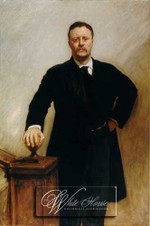 Over the next two months we’re going to hear a lot about Grover Cleveland.
Over the next two months we’re going to hear a lot about Grover Cleveland.
Cleveland, like Trump was President twice, listed as the 22nd and 24th. He came to town as a reformer, with just three years in politics behind him. He was a favorite of Mark Twain and other ‘Mugwumps,’ a financial and literary elite styled by the media as fake Indian chiefs.
Republican Benjamin Harrison beat Cleveland in 1888, and the next four years were devoted to revenging that loss. But the America of 1893 was quite different from that of 1889. Just as the America of 2025 is miles away from 2021.
The Panic of 1893
 Even before he returned to office that March, Cleveland was greeted by the Panic of 1893. As Wikipedia notes, it was the worst economic crisis before the Great Depression of the 1930s. It started on Wall Street. It didn’t stay there.
Even before he returned to office that March, Cleveland was greeted by the Panic of 1893. As Wikipedia notes, it was the worst economic crisis before the Great Depression of the 1930s. It started on Wall Street. It didn’t stay there.
When stocks and other assets fell in value during the Panic, there was no backstop. There was no deposit insurance. The Federal Reserve was not created until the 1910s. When your bank failed your money disappeared. All the institutions we take for granted, the ones Trump wants to do away with, were created from the memories of 1893.
As the recession deepened, the costs of government rose. But Cleveland didn’t have the access to money we have in the 21st century. The government was almost wholly dependent on tariffs. (Imagine that!) Tariffs, taxes on imported goods, are often reciprocated, reducing world trade, spreading the contagion. The gold standard, based on the idea that gold was money (much like Bitcoin today), also made things worse.
To keep the U.S. from going bankrupt, Cleveland was forced to borrow gold from J.P. Morgan and the English Rothschild family, at a staggering 4% interest. He delayed the move as much as he could, until after the 1894 election, but the damage was done. His entire political movement, a conservative democracy tied to business interests, vanished without a trace.
Lessons for Today

This is how the Progressive Era began.
I think Cleveland made the best of a bad hand. He didn’t start the fire. But he was, politically, a dead man walking from the day he walked back into the White House.
When the AI world collapses, taking the global economy down with it, the same is likely to happen to Trump and Trumpism. Efforts to do what Cleveland did, breaking unions, destroying workers’ rights, will grind his coalition into dust.
What’s amazing is that Thiel is riding into all this with all flags flying. The big “economic program” is to return to the Cleveland economy, raising tariffs and killing the independence of the Federal Reserve. I can’t tell you if the result will be the same, but it certainly looks like it.










